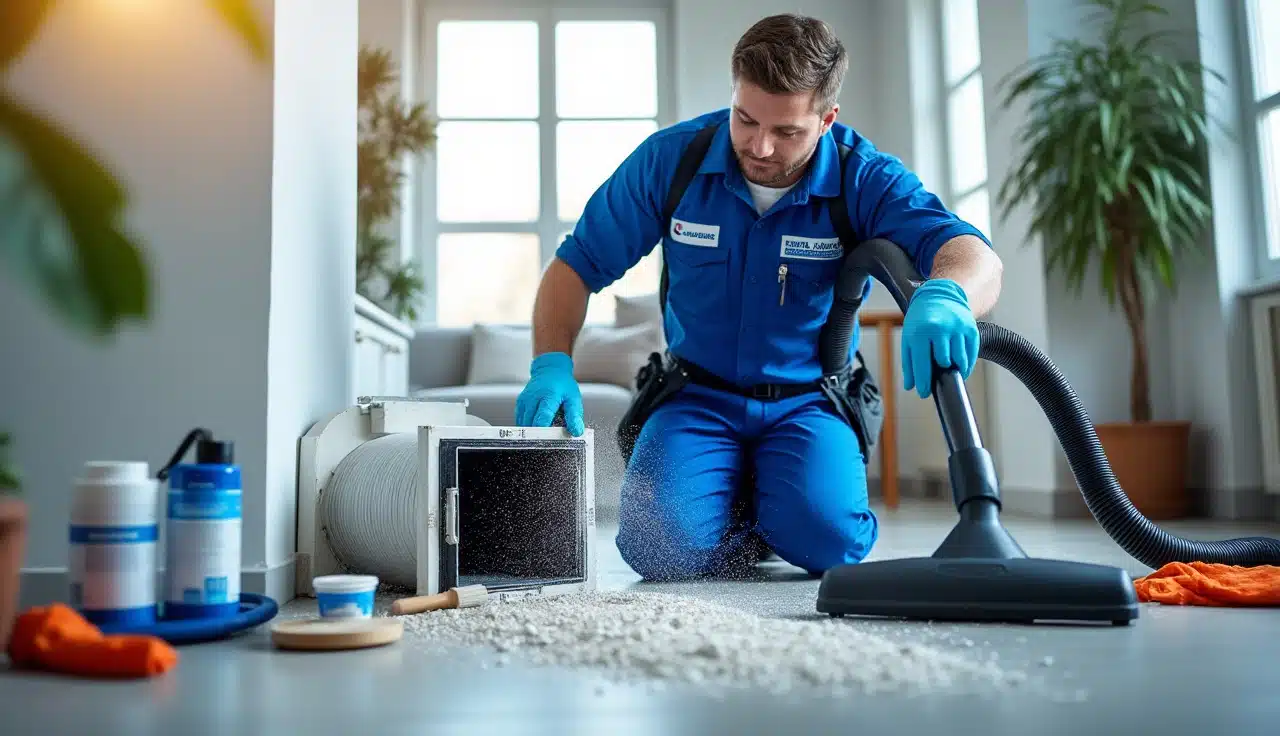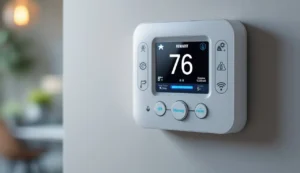
Duct cleaning and sealing do more than just clear dust—they’re your home’s secret weapons. Want cleaner air and lower bills? The EPA warns leaky ducts waste 30% of your HVAC’s energy, while the CDC links poor indoor air to rising asthma rates, especially in kids.
But here’s the twist: most homeowners miss the hidden risks. Dirty ducts don’t just spread allergens—they can leak carbon monoxide in gas-heated homes. Ever heard of smart sensors? These gadgets detect leaks silently costing you cash.
Think of ducts like a leaky water bottle: seal cracks, save what’s inside. Cleaning removes mold and dust you’re breathing right now. Sealing stops energy vampires sucking your wallet dry.
Bottom line? Pairing both tackles indoor air quality and energy efficiency in one move. Let’s dive into how—and why skipping one could cost you more than you think.
The Hidden Impact of Ductwork on Home Health

Hold your breath—literally. The air circulating through your ducts could be triggering allergies, asthma, and even carbon monoxide risks. The CDC warns that indoor air can be 2–5x dirtier than outdoor air. And 1 in 12 Americans battle asthma linked to poor air quality.
How Dirty Ducts Harm Your Health
Your ductwork acts like a hotel for mold spores, dust mites, and bacteria. Every time your HVAC kicks on, it blows these irritants into your living room. Imagine sneezing every time you adjust the thermostat. Worse, mold thrives in damp ducts, releasing spores that worsen respiratory health—especially for kids and seniors.
Gas-heated homes face a hidden danger: cracked ducts can leak carbon monoxide. This silent killer causes 400+ U.S. deaths yearly. Sealing gaps stops this toxic gas from creeping into your vents.
| Common Pollutants in Dirty Ductwork | Source | Health Risk |
|---|---|---|
| Mold spores | Humidity or leaks | Allergies, asthma attacks |
| Dust mites | Dead skin cells | Sneezing, congestion |
| Bacteria | Pet dander, moisture | Respiratory infections |
| Carbon monoxide | Cracked furnace ducts | Headaches, death |
Red Flags Your Ducts Need Attention
- Musty smells when the AC runs
- Allergy flare-ups only at home
- Visible dust puffing from vents
- Unexplained headaches or fatigue
Dirty ducts don’t just blow airborne particles—they recycle them. Think of it like stirring a soup of allergens with every breeze from your vents. A quick duct cleaning and sealing stops this cycle. Pro tip: Pair it with a HEPA filter to slash asthma triggers by up to 60%.
Bottom line? Your ducts are your home’s hidden immune system. Keep them clean, and you’ll breathe easier—literally.
Energy Efficiency: The Overlooked Financial Benefit
Let’s cut to the chase: your home’s HVAC system might be burning cash like a broken gas pump. The U.S. Department of Energy says 25-40% of heating/cooling energy escapes through leaks. That’s like tossing $300+ a year out a window.
Stop Wasting Money on Air
Duct leaks let conditioned air slip into attics or crawl spaces. Your system works overtime, hiking up energy costs. Fixing this is simpler than you think:
– DIY sealing (using foil tape or mastic) costs under $50 and takes an afternoon.
– Professional sealing uses industrial-grade sealing materials and blower-door tests for 90%+ efficiency.
| Sealing Method | Cost | Time | Energy Savings |
|---|---|---|---|
| DIY (Foil Tape) | $30 | 3 hrs | 15-25% |
| Pro Service | $500 | 1 day | 40-60% |
Find Leaks Before They Drain You
Smart home tools like thermal cameras or airflow sensors spot hidden leaks. Example: The Keen Home Smart Vent adjusts airflow automatically. Pair this with a professional energy audit ($100-$300) to prioritize fixes.
How Proper Sealing Lowers Carbon Monoxide Risks
Leaky ducts aren’t just expensive—they’re dangerous. In homes with gas systems, gaps can cause backdrafting. This sucks exhaust fumes into your living space instead of outside.
Think of it like a car’s tailpipe leaking into the cabin. Carbon monoxide has no smell, but sealing ducts keeps airflow moving away from your family. Pro tip: Install a $30 CO detector near bedrooms for extra safety.
Quick Safety Checklist
☑️ Seal ducts near gas appliances first
☑️ Replace cracked furnace flues
☑️ Test CO detectors monthly
Bottom line? Duct cleaning and sealing isn’t just about saving money. It’s about keeping your home’s air safe, efficient, and yours.
When to Prioritize Duct Cleaning vs. Sealing
Let’s cut through the confusion: your ducts are like your home’s lungs. When they’re clogged or leaky, your HVAC system struggles to breathe. Here’s how to know which fix it needs.
The Quick Decision Flowchart
Use this simple trick to choose:
– Clean if you spot visible mold, dust blasting from vents, or foul odors.
– Seal if you’re battling sky-high energy bills or rooms that never feel the same temperature.
| Scenario | Action |
|---|---|
| 🤢 Musty smells | Clean immediately |
| 💸 $300 monthly bills | Seal leaks first |
| 🏗️ Post-renovation dust | Clean + inspect |
| 🌡️ Hot/cold spots | Seal gaps + insulate |
Myth Busting: What Most Homeowners Get Wrong
- ❌ Myth: “Cleaning fixes leaks.”
Truth: Cleaning removes gunk. Sealing stops air escapes. They’re separate jobs. - ❌ Myth: “Sealed ducts never need cleaning.”
Truth: Sealing prevents new dust, but old debris? That still needs a scrub.
The Overlooked Time to Clean
Did you just finish a remodel? Post-renovation cleaning is a must. Drywall dust and insulation bits love to hide in ducts. Even if you don’t see mold, this preventative maintenance stops allergies before they start.
When to Call a Pro (and What to Ask)
- ✅ Hire cleaners if:
- You see cobwebs or rodent droppings in vents.
- Family members sneeze nonstop.
- ✅ Hire sealers if:
- Your energy bills jumped 20%+.
- You hear whistling noises near ducts.
Always ask service providers for:
1. Before/after photos of your ducts.
2. A detailed quote (no hidden fees).
3. Proof of licensing/insurance.
Quick tip: Start with a duct inspection. Many companies offer $99 checkups. You’ll get a clear “clean vs. seal” roadmap without guessing.
Beyond Traditional Methods: Advanced Techniques You Haven’t Considered
You know that dusty feeling in your home no matter how much you clean? The secret might be hiding in your ducts. Let’s explore new solutions that go beyond basic vacuuming and tape.
Aeroseal vs. Traditional Mastic: A Cost-Benefit Breakdown
Mastic sealant (a sticky paste) has been the go-to for sealing leaks. But Aeroseal’s polymer technology works like magic—it’s blown into ducts and clings to gaps automatically. Here’s how they stack up:
| Factor | Mastic Sealant | Aeroseal |
|---|---|---|
| Upfront Cost | $300–$600 | $1,000–$2,500 |
| Longevity | 5–8 years | 15+ years |
| Energy Savings | 10–15% | 20–30% |
| Installation Time | 4–6 hours | 2–3 hours |
(Source: HVAC industry reports 2023)
Aeroseal costs more upfront but pays off in long-term energy savings and less hassle. Think of it like buying a phone case that never cracks.
Pro Tip: After cleaning ducts, sanitize them! Two tools do this best:
– Air scrubbers: Suck up mold spores and dust like a super-powered vacuum.
– UV-C lights: Zap bacteria and viruses (like a “sunlight disinfectant” for your ducts).
Ozone treatment is another option, but it’s controversial. While it kills odors, high levels can harm pets or plants. Always hire a pro for this.
Final Takeaway
Skip the duct tape. Modern solutions like Aeroseal and UV-C lights work smarter, last longer, and cut energy bills. Want cleaner air and savings? These upgrades are worth every penny.
Smart Home Integration: The Future of Duct Maintenance
Picture this: your home’s ductwork talks to you before a problem even happens. That’s the power of IoT-enabled duct pressure sensors. These tiny gadgets monitor airflow 24/7, spotting leaks faster than a technician with a clipboard.
How Smart Tech Works With Ducts
Smart home systems now sync with HVAC systems to auto-adjust airflow. If your air quality sensors detect dust or humidity spikes, your vents respond instantly. No more guessing games—just cleaner air, lower energy bills, and fewer repair surprises.
Here’s the game-changer: preventative alerts. Imagine getting a text like, “Hey, your bedroom duct pressure dropped 20%—check for leaks!” These warnings help you fix small issues before they become $$$ disasters.
IoT Sensors for Real-Time Air Quality Monitoring
Devices like Awair or Kaiterra act like fitness trackers for your air. They measure particles, CO2, and humidity, then send data straight to your phone. Pair them with duct cleaning and sealing, and you’ve got a dynamic duo for healthier indoor air.
Pro tip: Place sensors near vents and bedrooms for the clearest snapshot of your duct system’s performance.
Smart Home vs. Traditional Duct Maintenance
| Feature | Traditional Methods | Smart Home Integration |
|---|---|---|
| Leak Detection | Manual inspections (~$300) | Real-time alerts ($0 after setup) |
| Air Quality Tracking | Guesswork + lab tests | Live data on your phone |
| Energy Savings | Up to 15% | Up to 30% with auto-adjustments |
Why this matters for duct cleaning and sealing:
– Stops leaks before mold or pests invade
– Extends HVAC lifespan by reducing strain
– Lowers monthly energy costs and carbon footprint
Bottom line? Smart home integration turns your ducts from “out of sight, out of mind” to “always optimized.” It’s like giving your home a sixth sense for clean air.
Duct cleaning and sealing isn’t just about comfort—it’s about creating a healthier, more efficient home. Imagine your HVAC system as your home’s heartbeat: clean ducts mean cleaner air, while sealed ducts keep energy bills in check.
Here’s the takeaway:
– Breathe easier: Dirty ducts trap mold and allergens, triggering asthma attacks (CDC says 1 in 12 adults have asthma!). Cleaning removes these hidden threats.
– Save smarter: The DOE warns that leaky ducts waste 25-40% of heating/cooling energy. Sealing fixes that—fast.
– Stay safe: Gas-heated homes? Leaky ducts can pull carbon monoxide into living spaces. Sealing isn’t optional—it’s critical.
Tech like smart sensors or Aeroseal takes guesswork out of maintenance. Pair these with seasonal checkups, and your system runs smoother, longer.
Don’t wait for dust or sky-high bills to act. Schedule online now—your lungs and wallet will thank you.





